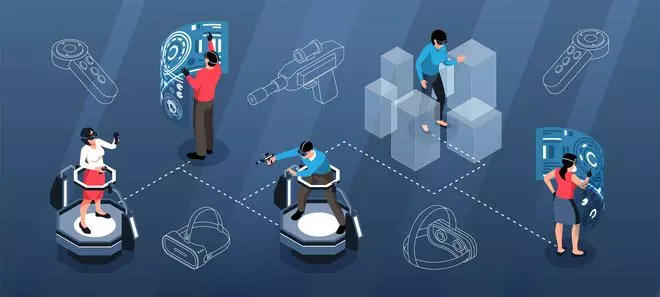Metaverse is the new buzz captivating technology innovators everywhere. While the technology is providing customers with an immersive experience, it is also expanding businesses opportunities. However, the metaverse opportunity can only be fully leveraged with efficient internet penetration including 5G, WiFi, in-home fiber, private networks, satellite broadband and more. These experience-rich services will require a high throughput connection that can reliably support intensive, seamless experiences on demand.

According to an industry report by Credit Suisse, transition of the digital ecosystem to metaverse will push data usage by 20 times across the globe by 2032.
The metaverse has the promise and potential to become an extension of people’s lives—opening the door into a parallel virtual reality where people could opt to live, work, and play continuously in real-time. Some describe it as the next generation of the internet – and certainly if appropriately realized -- it could be every bit as positively disruptive if it delivers on its promise.
Due to dependent relationships, communications service providers (CSPs) are in a prime position to enable and participate in the endless opportunities metaverse has to offer. Additionally, along with telecom service providers, technology companies and policymakers need to collaborate to achieve network enhancements and building an efficient infrastructure that supports 5G and high-end technology like metaverse. The ecosystem needs to together redefine hybrid local and remote real-time rendering, data compression, spectrum auction at affordable price to work on metaverse readiness of future connectivity and cellular standards. Moreover, network optimizations, improved latency between devices and within radio access networks also needs to be reconsidered.
However, as CSPs look to expand offerings to meet customer demands, there are potential barriers to entry to consider when optimizing networks for the digital future.
An efficient network to handle the metaverse
In terms of advance connectivity, there are numerous wireless connectivity technologies today that must be addressed. Bluetooth lacks range, rate, and reliability. Current generations of WiFi offer the required speed but suffer from congestion and high latencies once multiple devices are added.

I believe there will be opportunities for CSPs to act as aggregators for different types of networks. When it comes to advance connectivity, a seamless end-to-end customer experience will be a critical piece of the puzzle, either when coming or going from a network. AI and network governance will become increasingly important to manage this.
Why standalone 5G is crucial
To embrace the total flexibility of standalone 5G, CSPs are exploring the idea of “cloudifying” their networks to support the kind of content-rich services expected in the future – both in scaling their central functions and providing services at the edge. They are embracing metaverse and accelerating 5G rollouts, to stay relevant and secure the market share.
With 5G, networks can provide ultra-reliable low latency communication (URLLC) while also satisfying the quality of service (QoS) issues and guaranteeing the quality of experience continuously through dedicated service slices. The metaverse will require high throughput, and URLLC means that the network is optimized to process very high volumes of data packets with a massively low tolerance for delay. This means no buffering and an unprecedented level of real-time capability, imperative in virtual reality experiences. Through 5G, delivering the service, managing the QoS, and monetizing the digital assets is achievable should network prioritize the needed steps to get it to the level of required ubiquitous connectivity for the metaverse.
Bundling costs for a better metaverse
Right now, the metaverse highly depends on having VR (Virtual Reality), AR (Augmented Reality), and MR (Mixed Reality) technologies and devices to access it. Therefore, it will likely make the most business sense for the big tech companies to pay for building the infrastructure and for consumers to pay for the hardware (like VR/AR sets) and access to the infrastructure (through payments to telecoms). Like paying a phone, cable or streaming platform bill today, consumers could be adding a metaverse bill to their monthly expenses in the future—opening the door to more revenue streams for CSPs. And the “access devices” will get better and better over time – ultimately becoming a fashion accessory much as phones have done.
Offering metaverse-type packages would allow operators to tap into the experience services market and lowers costs for consumers by providing bundled services that ensure network speed and latency. For example, building a package could include everything a customer needs to enjoy an immersive metaverse experience: from a connection that seamlessly transitions from indoor wireless access to outdoor coverage to the necessary hardware accessories like VR/AR headsets. Operators could even bundle a subscription with a headset and a connection for a specialized event or partnership, such as an all-season pass to MLB, NFL, NBA, etc.
Seamless internet connectivity
Lowering the barriers to entry for consumers will be critical in making the metaverse a thriving ecosystem. The most pressing matter is providing “metaverse grade” ubiquitous connectivity. The scaling flexibility of 5G’s high throughput and low latency benefits will go a long way to achieving this, which will tackle the barriers to adoption for consumers.

It will be interesting to see how the adoption and adaptation of the Metaverse in India will be leveraged by telcos and other industry players to create immersive experience for consumers across industries. From retail, to automobile, entertainment to media, healthcare and industries metaverse will be a gamechanger for all opening opportunities for companies to reach out to their customers.
The author is General Manager, Amdocs Network







Comments
Comments have to be in English, and in full sentences. They cannot be abusive or personal. Please abide by our community guidelines for posting your comments.
We have migrated to a new commenting platform. If you are already a registered user of TheHindu Businessline and logged in, you may continue to engage with our articles. If you do not have an account please register and login to post comments. Users can access their older comments by logging into their accounts on Vuukle.